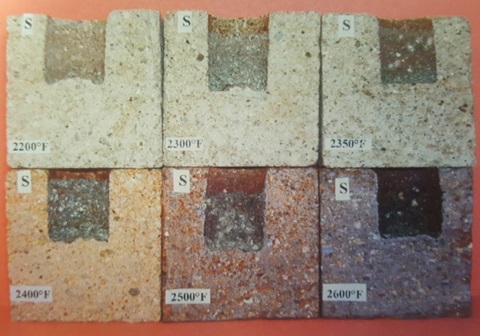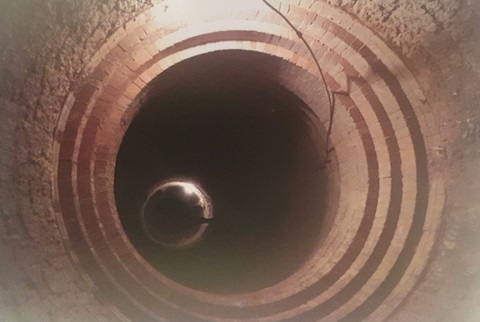Rotary Kiln Burning Zone Refractory Challenges
Articles
Part 1: Charging Zone
Part 2: Calcining Zone
Part 4: Discharge Zone

Lime-filled refractory cup tests of high alumina (60% Al2O3) brick show that fluxing starts to occur between 2350°F (1288°C) and 2400°F (1316°C) by the appearance of a dark gray coating inside the cup.
Magnesite-spinel brick (RESCOMAG® 85) burning zone dam uses a relatively thick refractory construction.
Burning Zone Refractory Challenges

When an alumina-silica refractory is fluxed by lime in a rotary kiln, the lining appears abraded or washed away. An individual refractory brick exhibits two hallmark features: a greatly varying remnant thickness and a thin, dark grey hot face coating. Based on laboratory refractory cup tests, high alumina brick can react with the lime charge between 2450°F (1288°C) and 2400°F (1316°C). Figure 3 illustrates this, as a dark grey coating has formed inside the refractory cup.
Brick hot face temperatures in the burning zone commonly exceed 1260°C (2300°F) necessitating the use of basic brick. Basic refractories are chemically more compatible with the lime charge than high alumina brick. Magnesite-spinel bricks are most commonly selected for the burning zone. Magnesite-spinel bricks feature excellent spalling resistance and great durability for burning zone service.
It is not uncommon for rotary lime kilns in North America to operate with burning zone shell temperatures exceeding 800°F (427°C). Some operators have resorted to two-layer brick constructions in the burning zone to manage shell temperature issues. There is a great difference in the coefficient of thermal expansion between magnesia (the hot-face layer) and alumina-silica (the back-up layer) brick. This mismatch can cause instability of the hot face layer.
Magnesite-spinel bricks are binary combinations of dead-burned magnesite (MgO) and magnesia-alumina spinel (MgO-Al2O3). The alumina (Al2O3) content is a marker for the magnesia-alumina spinel in the refractory. Spinel is the more insulating component. Generally, the higher the alumina content, the greater the insulating value of the brick and, consequently, the lower the kiln shell temperature.
The second step to address high burning zone shell temperatures is to install a thicker lining. A common practice for a rotary kiln lining in North America is 220 mm (8.66in.) thickness. Burning zone linings of 250 mm (9.84in.) are becoming more frequent. Historically, in larger diameter kilns, burning zone linings as thick as 305 mm (12 in.) were used. It is unclear what the limit of thickness for a basic brick lining is, as a brick lining of 457 mm (18 in.) has performed successfully in a burning zone dam construction. (Figure 5)

